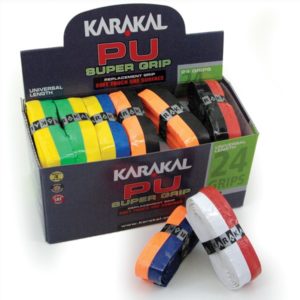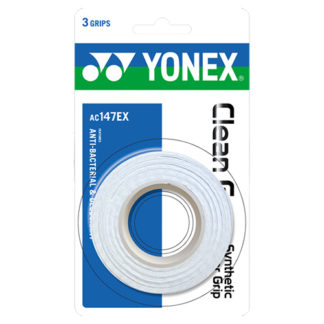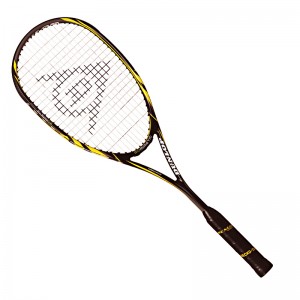
In fact, every time you hit hard shots off center, the squash racquet will turn in your hand. The more it turns in your hand, the more shots you will miss.
Most recreational squash players don’t understand the importance of grip. They think it is an unimportant part of the racquet when it is actually more important than the string bed.
A squash player who has good traction on his racquet handle can play well with new strings or old strings. But a player with no traction on his handle can’t play well with either.
Racquet Network offers free labour for re-gripping squash racquets in our southwest Calgary store. The whole process only takes a few minutes. We can usually do it right on the spot.
Racquet Grip
Racquet Network carries a large selection of grips for squash and other racquet sports. Bring your racquet into the store and we will professionally re-grip it for you.
-

Yonex Tacky Fit 3 Pack
CAD $15.00 -

Babolat Zeoclean Overgrip
CAD $9.00 -

Yonex Clean Grap 3 Pack
CAD $13.00 -

Tourna Pickleball Cushion Grip
CAD $10.00 -

Yonex Moist 3 Pack
CAD $15.00 -

Tourna Mega Tac
CAD $10.00 -

Tourna Pickleball Mega Tac Grip
CAD $7.00 -

Tecnifibre Squash Grip
Price range: CAD $0.00 through CAD $9.99 -

Babolat Pro Tour
Price range: CAD $9.00 through CAD $70.00 -

Tecnifibre Pro Players Ovegrip
CAD $12.00 -

Babolat Syntec Touch Replacement Grip
-

Yonex Super Grap – 30 Pack
CAD $69.99 -

Tourna Tac
CAD $9.00 -

Babolat Pro Skin
Price range: CAD $9.00 through CAD $27.00 -

Karakal PU Super Grip – Box of 24
CAD $149.99 -

Yonex Leather Badminton Grip
CAD $9.00 -

Babolat Pro Tacky
Price range: CAD $9.00 through CAD $30.00 -

Babolat Pro Tour Traction
Original price was: CAD $8.50.CAD $8.00Current price is: CAD $8.00. -

Tourna Grip
CAD $9.00 -

Yonex Super Grap Single
CAD $5.00 -

Karakal PU Super Grip – Singles
CAD $11.99 -

Tourna Pickleball Grip
CAD $7.00 -

Yonex Wave Grap
CAD $7.00 -

Tecnifibre Pro Contact
CAD $12.00 -

Yonex Towel Grip
CAD $6.00 -

Yonex Mesh Grap 3 Pack
CAD $12.00 -

Yonex Super Grap 3 Pack
CAD $9.00 -

Yonex Dry Grap 3 Pack
CAD $13.00 -

Babolat Pro Team SP Overgrip
CAD $9.00




 It doesn’t matter what you are buying — racquets, shoes, string, accessories — price should not be your most important consideration. If it is, you will almost certainly make a poor decision.
It doesn’t matter what you are buying — racquets, shoes, string, accessories — price should not be your most important consideration. If it is, you will almost certainly make a poor decision.